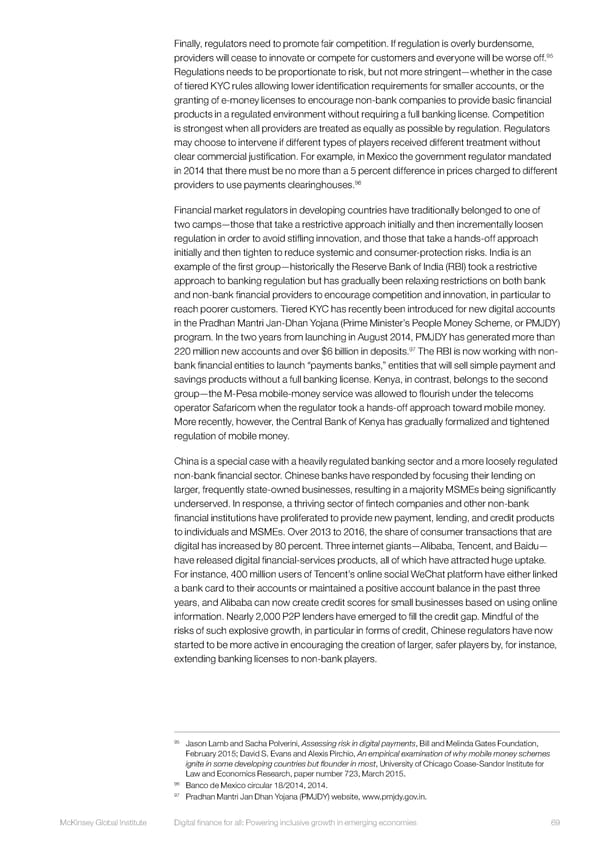Finally, regulators need to promote fair competition. If regulation is overly burdensome, 95 providers will cease to innovate or compete for customers and everyone will be worse off. Regulations needs to be proportionate to risk, but not more stringent—whether in the case of tiered KYC rules allowing lower identification requirements for smaller accounts, or the granting of e-money licenses to encourage non-bank companies to provide basic financial products in a regulated environment without requiring a full banking license. Competition is strongest when all providers are treated as equally as possible by regulation. Regulators may choose to intervene if different types of players received different treatment without clear commercial justification. For example, in Mexico the government regulator mandated in 2014 that there must be no more than a 5 percent difference in prices charged to different 96 providers to use payments clearinghouses. Financial market regulators in developing countries have traditionally belonged to one of two camps—those that take a restrictive approach initially and then incrementally loosen regulation in order to avoid stifling innovation, and those that take a hands-off approach initially and then tighten to reduce systemic and consumer-protection risks. India is an example of the first group—historically the Reserve Bank of India (RBI) took a restrictive approach to banking regulation but has gradually been relaxing restrictions on both bank and non-bank financial providers to encourage competition and innovation, in particular to reach poorer customers. Tiered KYC has recently been introduced for new digital accounts in the Pradhan Mantri Jan-Dhan Yojana (Prime Minister’s People Money Scheme, or PMJDY) program. In the two years from launching in August 2014, PMJDY has generated more than 97 The RBI is now working with non- 220 million new accounts and over $6 billion in deposits. bank financial entities to launch “payments banks,” entities that will sell simple payment and savings products without a full banking license. Kenya, in contrast, belongs to the second group—the M-Pesa mobile-money service was allowed to flourish under the telecoms operator Safaricom when the regulator took a hands-off approach toward mobile money. More recently, however, the Central Bank of Kenya has gradually formalized and tightened regulation of mobile money. China is a special case with a heavily regulated banking sector and a more loosely regulated non-bank financial sector. Chinese banks have responded by focusing their lending on larger, frequently state-owned businesses, resulting in a majority MSMEs being significantly underserved. In response, a thriving sector of fintech companies and other non-bank financial institutions have proliferated to provide new payment, lending, and credit products to individuals and MSMEs. Over 2013 to 2016, the share of consumer transactions that are digital has increased by 80 percent. Three internet giants—Alibaba, Tencent, and Baidu— have released digital financial-services products, all of which have attracted huge uptake. For instance, 400 million users of Tencent’s online social WeChat platform have either linked a bank card to their accounts or maintained a positive account balance in the past three years, and Alibaba can now create credit scores for small businesses based on using online information. Nearly 2,000 P2P lenders have emerged to fill the credit gap. Mindful of the risks of such explosive growth, in particular in forms of credit, Chinese regulators have now started to be more active in encouraging the creation of larger, safer players by, for instance, extending banking licenses to non-bank players. 95 Jason Lamb and Sacha Polverini, Assessing risk in digital payments, Bill and Melinda Gates Foundation, February 2015; David S. Evans and Alexis Pirchio, An empirical examination of why mobile money schemes ignite in some developing countries but flounder in most, University of Chicago Coase-Sandor Institute for Law and Economics Research, paper number 723, March 2015. 96 Banco de Mexico circular 18/2014, 2014. 97 Pradhan Mantri Jan Dhan Yojana (PMJDY) website, www.pmjdy.gov.in. McKinsey Global Institute Digital finance for all: Powering inclusive growth in emerging economies 69
 DIGITAL FINANCE FOR ALL Page 83 Page 85
DIGITAL FINANCE FOR ALL Page 83 Page 85